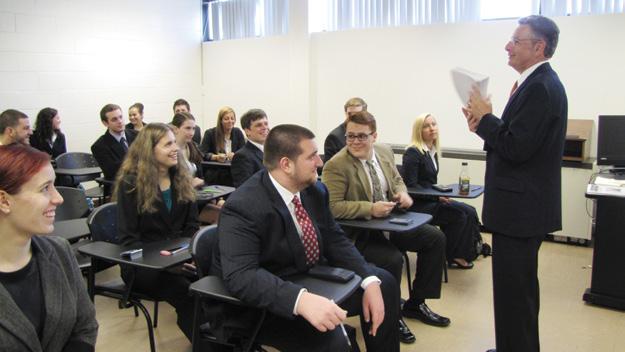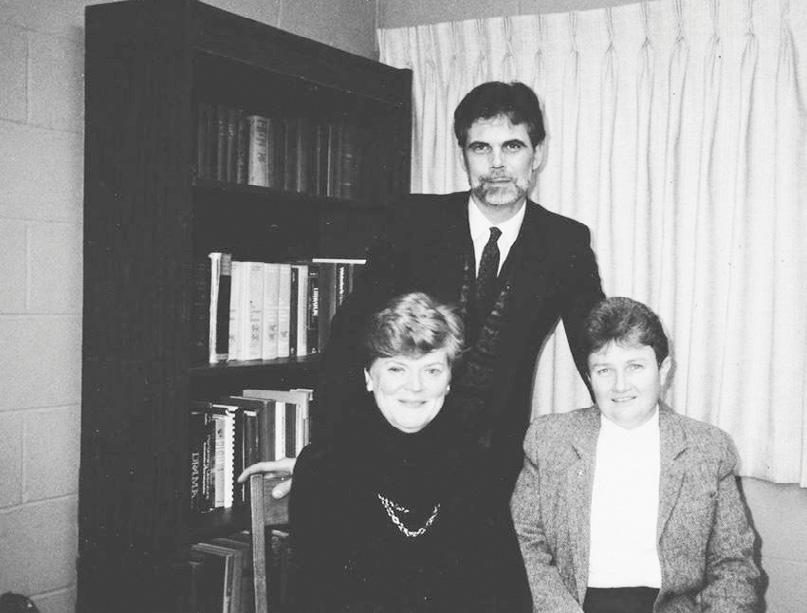
10 minute read
Emeritus professors look back
Early Mount memories
Professors look back with fondness
Above: Arts and Letters veterans James Beard, Sr. Catherine Walsh (bottom right), and Irene Nunnari (bottom left) circa the mid-1980s. Dedicated. Unforgettable. Iconic. For alumni of Mount Saint Mary College, that’s the only way to describe seminal faculty members like James Beard, professor emeritus of Communication Arts; Sr. Catherine Walsh OP ’70, professor emerita of Communication Arts; Louis Fortunato, professor emeritus of Accounting; and Andrea Ackermann, professor emerita of Nursing. Before their retirement, these four professors tenured a total of more than 110 years of service to the college. Their devotion to their students, their profession, and the Mount are outstanding.
Recently, they shared some of their favorite memories of the Mount.
The early days
Beard and Sr. Walsh joined the Mount family in the early 1980s. The campus, they noted, was quite different back then: Hudson Hall served as the Jewish Community Center, Sakac Hall and the Elaine and William Kaplan Recreation Center didn’t exist yet, and the Dominican Center had not yet become part of the college. Casa San José – which had served as an elementary school many years ago, and later as office space – was still standing near Guzman Hall.
“The facilities were not what we have now,” explained Sr. Walsh. “However, it was a place with an emphasis on student success and involvement. Programs were growing or straining to grow. Space was a big issue; office space and student space. But we managed. Yes, we whined, but we kept at the mission. I was always amazed at the dedication of all.”
Around that time, it was not uncommon for faculty members in different fields to share the same office suites. For example, Joan Miller from Education – now a professor emerita herself – was stationed in the same wing as Arts and Letters.
One day the college’s power went out, Sr. Walsh said, and “offices without windows were in complete darkness. Well, those of us with windows still came out to chat, but there was Joan Miller in a very dark office correcting papers to the light of her cigarette. Yes, smoking was allowed in the building then. We joked with Joan about her dedication.”
Ackermann joined the Mount faculty right before the turn of the century in 1999 – nearly a decade before the Mathematics, Science, and Technology (MST) addition to Aquinas Hall was built and about 15 years before the Dominican Center would host the Kaplan Family Library. While the college had grown significantly since the decade of Ronald Reagan, The Golden Girls, and Pac-Man, when she started, things on campus were still a bit cozy.
“The college was smaller then,” Ackermann said. “Our enrollment was fewer as well, which gave me more time with each student. We also had less equipment, labs, and technology back then, too. My first office was in the Villa attic.”
There were, however, some advantages to having a smaller campus. Beard noted that the
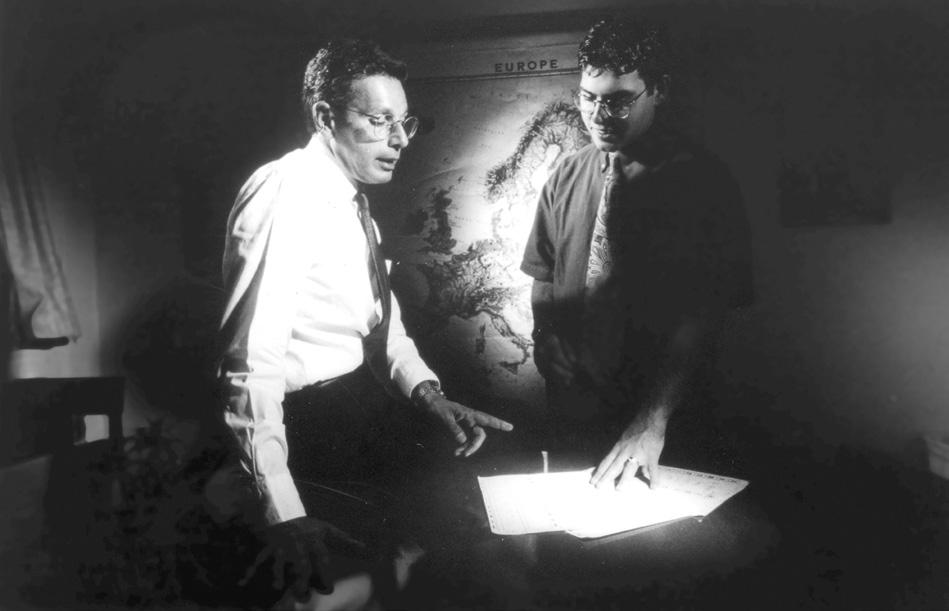
Professor Lou Fortunato
college’s size “proved an ideal atmosphere for a new and inexperienced faculty member to learn and grow. Limited faculty meant maximum opportunity to participate in governance committees, to mentor student clubs, to develop new courses, and to help build a young college.”
As those new courses were developed, the older ones evolved with the times. Fortunato started his nearly three-decade career at the Mount in 1987. By the time of his retirement, he said, Accounting courses had changed greatly in response to shifting business trends and requirements.
Most notably, there was a massive leap in technology, he said.
Education in the digital age
Thanks to technology, education delivery methods both inside the classroom and out have “changed drastically” and become “more dynamic and efficient,” Fortunato explained. Put simply, education has “gone from chalk and talk to the digital age.”
The era of computers and virtual workspaces evolved slowly in the ’80s and early ’90s, compared to the breakneck pace of technology in 2022, noted Fortunato. But by the late ’90s and early 2000s, the Mount – and the rest of the world as well – was fully entrenched in this new era of technology.
One example of this, noted Ackerman, is the educational technology Mount Nursing students use in the college’s medical labs. It provides them the training they need to be successful in the modern medical field.
“When I first started at the Mount…we had classes, static and practice labs, and off-campus clinicals,” she explained. “As time went on, fewer clinical opportunities were available in which the students could participate. In response, we were able to get funding for the creation of the Nursing Simulation Center. It took years to develop, but it gave students a chance to care for a [simulated] patient, develop skills, increase communication, and use decision making. I dedicated my time to developing the new labs when the MST building was completed and the upgrades to Aquinas Hall were finished. This brought us new opportunities for learning.”
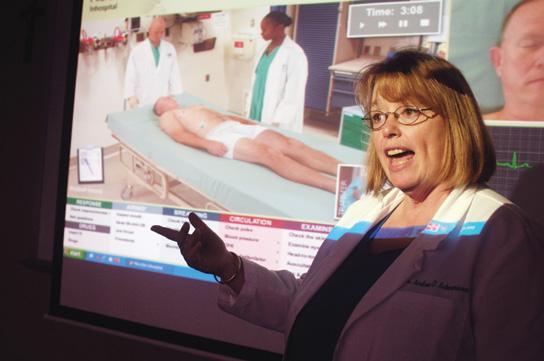
Top: Louis Fortunato works on a project with his student, Vincent Mattarella ’97.
Above: Andrea Ackermann teaches a class in the 2000s.
What the Mount has now in terms of technology is a far cry from when Sr. Walsh started at the college. She has vivid recollections of building the college’s first TV studio, complete with analog tape decks and large cameras.
“The studio was small, in the cloakroom of the theatre,” Sr. Walsh explained. “We had three cameras and three portable recorders. Students could sign them out to do their productions. Imagine my surprise when I heard that a set of equipment was in Pops Paradise on Gidney Avenue – a neighborhood bar – filming the reaction to the Tawana Brawley case [of 1988]. Those early productions were thoughtful, timely, and challenging.”
Celebrating success
Anyone who took classes taught by these professors will agree: their students always came first.
Beard often burned the midnight oil for the benefit of his theatre students. Though it could be exhausting, it was an experience he’s thankful he had.
“Directing student productions required evenings and weekends of long, hard work,” he explained. “A cast and crew can build camaraderie quickly, often becoming a family. It was a great joy to watch inexperienced student performers and production staff grow in confidence and ability, and I was honored that they put their trust in me to guide them.”
For Ackerman, one of the highlights of her career was seeing her students graduate and head out into the work world.
“I always enjoyed the end of the academic year, but not because the students were leaving campus; I missed them over the summer,” Ackerman said. “I enjoyed seeing the entire campus community joining together and celebrating the success of our students at the School of Nursing pinning ceremony and college Commencement. It was always a very joyful time for me.”
Fortunato fondly remembers asking his students to dress for their final exams as if they were going to a job interview. Ellen Bourhis Nolan – former director of Mount’s Career Center who retired in the Spring of 2022 – then evaluated the students’ attire through the lens of an employer. Fortunato upheld his “Dress for Success” tradition one more time for his final classes in December 2015. As always, it made him proud to see his students arrive wearing pressed shirts, shined shoes, and sharp suits. They could have walked out of the classroom and into the workplace – and that’s just what many of his students did, thanks in no small part to Fortunato’s mentorship.
“I’m hoping that my passion in the classroom has shown students that they can be enthused about their careers,” said Fortunato. “And when they look back, they can say, ‘I’m glad I came [to the Mount] and I look forward to tomorrow.’”
Friends forever
Even with the myriad of additions and physical changes to the campus over the years, the massive jumps in technology, and the fulfilling nature of their work, what has stuck with the four emeritus professors most is the friendships they made with their students and coworkers.
When asked what she missed most about teaching at the Mount, Ackermann replied, “This is easy: the students! I miss being with students, helping them, guiding them, or just chatting with them as they make their plans for after graduation. I love hearing from them now. I also miss all the people on campus…I felt a keen sense of community.”
While Beard doesn’t mind leaving the more tedious aspects of his career in the past, such as preparing classes, grading student work, or attending committee meetings, he does miss the students, faculty, and staff that made his time at the college some of the best days of his life.
“I was fortunate that my work at the Mount allowed me opportunities to build trust and friendship with many outside the classroom [and] of course, many strong bonds remain,” he said. “Several former students have honored me with visits, and Facebook has allowed me to connect with many alums, several of whom are now grandparents. While retirement has many rewards, I sincerely miss the day-to-day interaction with students, faculty, administrators, and staff. To me, the Mount’s strength

Aquinas Hall before the construction of the Kaplan Family Mathematics, Science and Technology addition.
Professors Beard and Nunnari in I Hate Hamlet
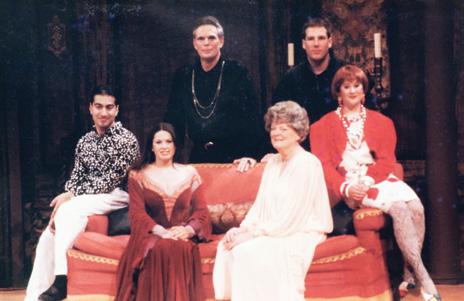
Ackerman at her farm Sr. Catherine Walsh in 2019
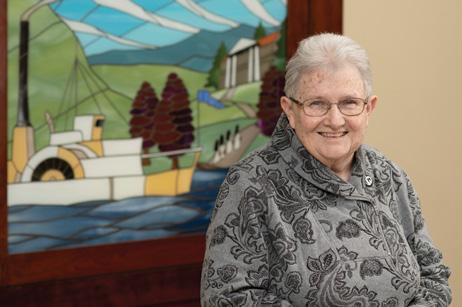
Students suited up for finals with Fortunato
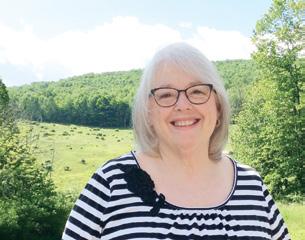
has always been its people and that genuine camaraderie we shared.”
Sr. Walsh agreed with her longtime friend and coworker: “Faculty bonded with students outside the classroom. We worked on the plays together and students were in our office area constantly to seek help with coursework or just to visit. I miss that student interaction. I miss seeing them grow in knowledge and into fuller adults. I miss the relationships with colleagues, however so many of us still get together. During COVID some of us met on Zoom almost every week.”
Life after MSMC
Since his retirement from the Mount, Beard continues to live in Newburgh with his husband, Jimi. Beard was known for encouraging his students to dress for success, and he practiced what he preached. Thankfully for him, retirement has offered Beard the opportunity to ease up a bit on his signature suit and tie look and enjoy life in more comfortable clothing.
Ackermann and her husband, Paul, moved out of the Hudson Valley and into Cherry Valley, in Otsego County, N.Y. They are currently putting the finishing touches on their new home, which they have been developing since 2007. It’s located on their very own farm.
“Working on the farm is tiring, but I enjoy it…We love it up here,” said Ackermann. “I have made many friends as I keep busy volunteering with the VFW Auxiliary, helping veterans and local military personnel who are deployed around the world. I am also busy with St. Mary of the Lake church in Cooperstown.”
For Sr. Walsh, “retirement” hasn’t quite been an accurate way to describe her post-teaching life. After her decades with the Mount, Sr. Walsh transitioned to a leadership position for the Dominican Sisters of Hope. When that term ended in 2019, she had intended to take a short sabbatical and then move on to volunteer work. But like so many other things, the pandemic forced a change of plans.
Currently, she said, “I have been chairing a task force for the five Dominican women’s congregations in the Northeast…and caring for our house and being in the community with the sisters has kept me busy.”
Since leaving the Mount in early 2016, Fortunato has continued to live in Newburgh with his wife Regina, herself a Mount alumna. He also manages his private practice, Louis P. Fortunato, CPA in the Town of Newburgh, N.Y. However, he will soon be retiring from that as well, after many years of service to the local community.
Fortunato summed up his time at the Mount in a single sentence: “I would never teach anywhere else!”
